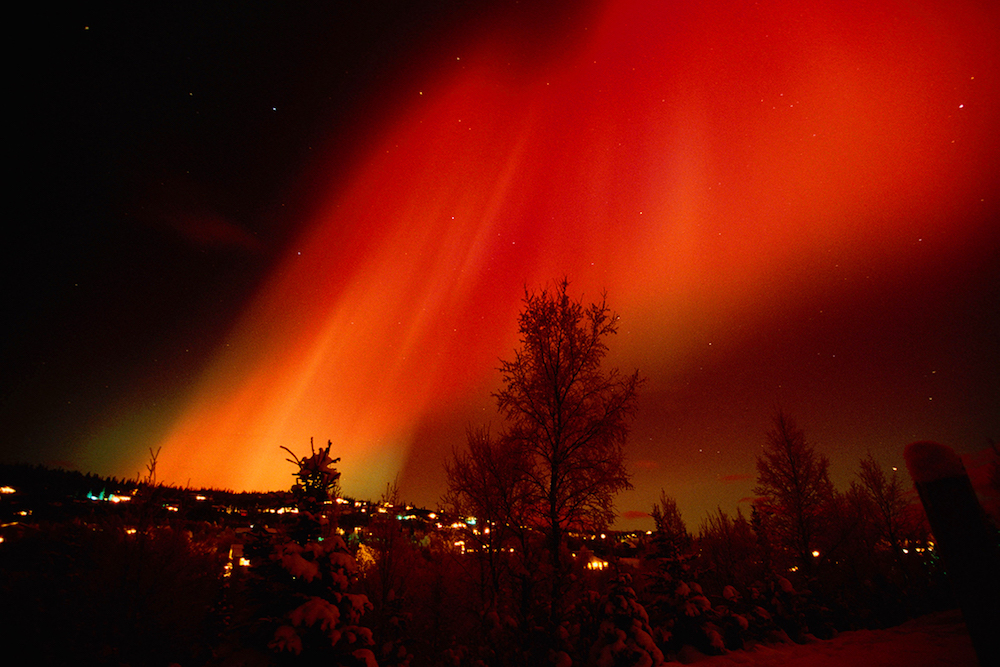Blood Red Skies Over China Explained 300 Years Later

On Sept. 10, 1770, the skies above China, Korea and Japan turned an eerie red, and for eight more nights these glowing red auroras lingered.
For nearly three centuries, this mysterious event was lost to history.
Now, researchers poring through palace diaries and other historical documents from East Asia have rediscovered the bizarre phenomenon, and have proposed a likely cause: A giant magnetic storm that rivaled the most powerful one on record, the so-called Carrington Event of 1859. (Geomagnetic storms occur when solar eruptions hit Earth's magnetosphere, the shell of electrically charged particles trapped by Earth's magnetic field.)
If a similarly massive magnetic storm hit Earth now, it could wreak havoc on power grids around the planet, researchers said. [The Sun's Wrath: The Worst Solar Storms in History]
Mysterious event rediscovered
To rediscover this cryptic event, Hisashi Hayakawa, a historian and astronomer at Osaka University in Japan, and his colleagues investigated historical records from China, Korea and Japan from the 18th century, looking for mentions of auroras. (Auroras, the radiant displays of colors in the sky known as the northern or southern lights, result from solar particles striking Earth's magnetosphere. They are usually most visible near the planet's magnetic poles, but when they occur at lower latitudes, far from Earth's poles, they can reveal evidence of geomagnetic storm activity.)
These types of "historical documents can let us trace back solar activity for millennia," Hayakawa told Live Science. For instance, records of auroras can be found in Babylonian astronomical diaries from 567 B.C., he said.
The team also examined sunspot drawings from the same period by amateur German astronomer Johann Caspar Staudacher, as well as records from Capt. James Cook's missions on the HMS Endeavour.
Sign up for the Live Science daily newsletter now
Get the world’s most fascinating discoveries delivered straight to your inbox.
After studying 111 historical documents, the scientists found evidence of red auroras seen throughout East Asia from Sept. 10 to 19, 1770. These long-lasting auroras were noticed at low latitudes, suggesting a powerful geomagnetic storm caused them.
The researchers also found these auroras were documented farther south by crew members aboard the HMS Endeavour near Timor Island in Southeast Asia. These findings are among the earliest known records of simultaneous auroral observations in both hemispheres.
"Considering this event was so large, it would be reasonable to find more events not only in East Asia but also in other low-latitude areas," Hayakawa said. As a result, the team is extending its archival surveys to areas as distant as the Middle East, Hayakawa added.
The team also scoured historical records for drawings of sunspots, which often co-occur with geomagnetic storms. These drawings suggested that sunspots during the 1770 event were twice as large in area as those seen during the Carrington Event, suggesting they were at least comparable in strength. During the notorious Carrington Event, electrical currents in the atmosphere zapped telegraph wires and caused paper from the devices to catch fire.
The research suggested the 1770 event affected at least as much of the globe as the Carrington Event. Moreover, the 1770 event's auroras were seen across nine nights, while the Carrington Event's were seen on just four nights.
"The events in 1770 lasted much longer," Hayakawa said.
As a result, scientists may need to rethink how frequently such powerful storms occur, the researchers said.
"Now we know the Carrington event was not a special one," study co-author Hiroaki Isobe, a solar physician at Kyoto University in Japan, told Live Science. "Such event occurs from time to time, roughly about once in 100 years."
Potentially catastrophic event
Given how dependent on electricity the world has become since the Carrington Event, if a similarly powerful geomagnetic storm were to hit now, unprecedented damage would result.
For instance, in 1989, a geomagnetic storm blacked out Quebec in 90 seconds, leaving 6 million customers in the dark for 9 hours, damaging transformers as far away as New Jersey, and nearly taking down U.S. power grids from the Eastern Seaboard to the Pacific Northwest. However, the Quebec event may have packed just one-tenth the power of the Carrington Event, prior work suggested.
A 2013 study from Lloyd's of London estimated a $2.6 trillion cost for North America if a Carrington-level storm happened now, and predicted "a Carrington-level, extreme geomagnetic storm is almost inevitable in the future."
"We believe we need to expect even more economic and social impacts for this kind of extreme and long-lasting magnetic storm," Hayakawa said.
The researchers are now looking for other historical examples of powerful magnetic storms. "We have already found another 1770-class event," Hayakawa said.
The scientists detailed their findings online Nov. 29 in the journal Astrophysical Journal Letters.
Original article on Live Science.











